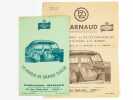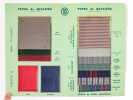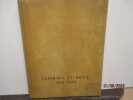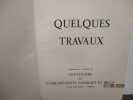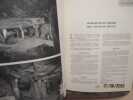-
Type
Art print (2)
Autograph (1)
Book (32940)
Magazine (147)
Manuscript (3)
Maps (1)
Photographs (8)
-
Latest
Last 24h (23)
Last 3 days (13)
Last month (197)
Last week (21)
-
Language
Chinese (1)
Dutch (2)
English (106)
French (32852)
German (10)
Greek (1)
Italian (112)
Japanese (1)
Latin (4)
Polish (2)
Portuguese (4)
Russian (3)
Spanish (3)
Swedish (1)
-
Century
16th (34)
17th (78)
18th (584)
19th (4504)
20th (12188)
21st (1813)
-
Countries
Belgium (6321)
Brazil (16)
Canada (11)
Côte d'Ivoire (35)
Denmark (145)
France (25369)
Germany (7)
Greece (3)
Netherlands (1)
Switzerland (1194)
-
Syndicate
ALAC (11)
CLAQ (3)
CNE (20)
ILAB (14295)
NVVA (498)
SLACES (497)
SLAM (13576)
SNCAO (64)
Vie de Saint-Quinis, évêque de Vaison,
Patron de la Paroisse de Gonfaron. Fréjus. Cisson. 1894. In-16 br.36pp. les 4 dernières occupées par des cantiques. Exemplaire fragile, un peu abîmé, couverture lgt tachée.
Les premiers évêques de Fréjus.-
Draguignan. Latil. 1891. In-8 (164 x 250mm) broché, couverture lilas imprimée, 120, VIII et (2) pages. Bords de couverture un peu abîmés sinon bon état. Exemplaire à grandes marges, non coupé, sans rousseurs. Edition originale, rare.
Les évêques de Fréjus du VIe au XIIIe siècle.-
Draguignan. Latil. 1894. In-8 (167 x 253mm) broché, couverture rouge brique imprimée, 210 pages. Bords de couverture et de feuilles un peu abîmés sinon bon état. Exemplaire à grandes marges, non coupé, non rogné, presque sans rousseurs. Edition originale, rare.
Cours raisonné et détaillé du bâtiment. 1ère partie : fondations. 2ème partie : maçonneries
,Paris, Ecole spéciale des travaux publics 1918, 176+335 pp., 1 vol. in 8 relié demi-percaline, dos lisse orné de filets dorés, titre or, figures in texte, cachets (ex-libris).
Cours raisonné et détaillé du bâtiment. 9ème partie: chauffage et ventilation
,Paris, Ecole spéciale des travaux publics 1919, pp., 1 vol. in 8 relié demi-percaline, dos lisse orné de filets dorés, titre or, figures in texte, cachets (ex-libris), illustrations in-texte
Cours raisonné et détaillé du batiment. 7eme partie. Travaux complémentaires couverture vitrerie peinture
Ecole spéciale des travaux publics Paris, Ecole spéciale des travaux publics 1924. In-8 relié demi-basane fauve, dos à nerfs, pièce de titre. 246 pages, figures. Bon état
Toutes les expéditions sont faites en suivi au-dessus de 25 euros. Expédition quotidienne pour les envois simples, suivis, recommandés ou Colissimo.
Cours raisonné et détaillé du Batiment. 4ème partie : Notions sur la RESISTANCE des MATERIAUX spécialement appliquée au batiment. Cours de M. G ESPITALLIER. Revu par M. Gaston LEFOL. Onzième édition.
P., Librairie de l'Enseignement Technique (Encyclopédie Industrielle et Commerciale), 1944, grand in 8° broché, 292 pages ; 153 figures ; couverture fanée, déchirure sans manque au 2ème plat.
...................... Photos sur demande ..........................


Phone number : 04 77 32 63 69
Le sein
ESKA 1995 644 pages 18x26x3cm. 1995. Cartonné. 644 pages. iconographie en noir et blanc et en couleurs
Bon Etat de conservation couverture un peu défraîchie tampon "specimen" sur la tranche
JOHAN CRETEN Strange Fruit
, Transit Gallery, 2015 Hardcover, , 245 x 175 mm, 80 pages, English edition. ISBN 9789081240734.
Johan CRETEN ( 1963, Belgium) is a Flemish sculptor based in Paris but working wherever he has the opportunity, from Miami to Mexico, from Den Haag to New York. He trained as a painter but soon turned to ceramics and bronze for his work. He has exhibited at the Louvre, at the Mus e Nationale Eug ne Delacroix in Paris, the Bass Museum of Art in Miami Beach, the Istanbul Biennale, the Mamco in Geneva, the Middelheimmuseum in Antwerp among many other places
THE STORY OF CARPETS
, STUDIO EDITIONS 1994, 1994 Hardcover, 160 pages, ENG, 305 x 240 mm, in good condition, lots of info, illustrations in colour. ISBN 9781851707270.
This book explains how a carpet is made, and looks at the associated symbolism of design and color. It is also a guide to choosing, buying and caring for a carpet, and a directory of carpet types.
Douze notre dix futur - essai sur la numération duodécimale et un système métrique concordant.
Dunod. 1955. In-8. Broché. Etat d'usage, Couv. défraîchie, Dos satisfaisant, Intérieur frais. 167 pages.. . . . Classification Dewey : 500-SCIENCES DE LA NATURE ET MATHEMATIQUES
Préface de M.Albert Caquot. Classification Dewey : 500-SCIENCES DE LA NATURE ET MATHEMATIQUES
Verre, glaces et cristaux. Collection Merveilles de la vie.
Belgique, Dupuis, s.d. (ca 1950/60). 15 x 21, 60 pp., nombreuses illustrations en N/B et en couleurs, cartonnage d'édition imprimé, bon état (couverture légèrement défraîchie).
Verre, glaces et cristaux. Collection Merveilles de la vie.
Belgique, Dupuis, s.d. (ca 1950/60). 15 x 21, 60 pp., nombreuses illustrations en N/B et en couleurs, cartonnage d'édition imprimé, bon état.
L'ordre mystérieux des Templiers. Éditions P.E.E.P. 1983.
1 volume in-8° broché, 173 p., illustrations. Infime trace de pliure en couverture, un timbre contrecollé en garde, très bel état.
Phone number : 06.31.29.75.65
Estelle Ingrand-Varenne, Elisa Pallotini, Janneke Raaijmakers ? (eds)
Reference : 64418
Writing Names in Medieval Sacred Spaces. Inscriptions in the West, from Late Antiquity to the Early Middle Ages
, Brepols, 2023 Hardback, xx + 386 pages, Size:156 x 234 mm, Illustrations:94 b/w, 26 col., 4 tables b/w., 3 maps color, Language(s):English, French. ISBN 9782503602363.
Summary This volume proposes a framework for reflection on practices of writing personal names in medieval sacred spaces, uniting historians, art historians, and specialists in written culture (both epigraphers and palaeographers). It traces the forms and functions of names that can be found within the space of early medieval churches and cemeteries, focusing mainly, but not solely, on inscriptions. By examining names written in various kinds of media, from liturgical books to graffiti and more formal inscriptions, the contributors investigate the intentions and effects of the act of writing one's own name or having one's name written down. Their interest resides less in the name itself than the interactions it had with its spatial, iconographic, linguistic, ritual, and cultural context, and what this indicates about medieval graphical practices. What is a name from a graphic point of view? What are the specificities of the epigraphic manifestations of names? By whom were names written, and for whom were they intended (if they were even meant to be accessed)? Addressing these and other questions, this volume shows the importance of inscriptions as historical sources and the contribution they give to the study of medieval societies at the intersection of history, anthropology, archaeology, linguistics, and semiology. TABLE OF CONTENTS Introduction ? VINCENT DEBIAIS Le nom et l' tre: De la th orie aux mises en forme pigraphiques ? ESTELLE INGRAND-VARENNE Graver son nom dans la pierre: Aspects techniques et culturels ? THIERRY GREGOR Topographie du nom du saint dans l' glise: L'exemple des inscriptions br ves de d dicace ? ANNICK GAGN Le nom, marque dans l'image et marqueur de l'objet ? VINCENT DEBIAIS Le nom l'oeuvre: Les signatures pigraphiques d'artistes et de commanditaires entre qu te de gloire et perspectives eschatologiques ? EMILIE MINEO Hic fuit: Scratching Names on Sacred Walls ? CARLO TEDESCHI Saints' Names and Relics: The Evidence of Church Inscriptions ? ELISA PALLOTTINI Ces morts dont on inscrit le nom dans la pierre ... ? C CILE TREFFORT Et breve in exigo marmore nomen ero: Un seul nom pour pitaphe (Gaule, Aquitaine, VIe-VIIIe s.) ? MORGANE UBERTI The Memory of a Person's Name ? JANNEKE RAAIJMAKERS The Social Meaning of Names ? JANNEKE RAAIJMAKERS Naming as a Liturgical Act ? ELS ROSE Beyond the Pale? Those Who Were Not Worthy to Be Named ? MARCO MOSTERT Conclusions ? ESTELLE INGRAND-VARENNE, ELISA PALLOTTINI, and JANNEKE RAAIJMAKERS Bibliography Indices
Painters and Sitters in Early-Seventeenth Century Rome. Portraits of the Soul
, Brepols, 2023 Hardback, 336 pages, Size:220 x 280 mm, Illustrations:6 b/w, 146 col., Language: English. ISBN 9782503590837.
Summary Significant innovations in portraiture occurred during the transitional period from the end of the sixteenth-century to the early seventeenth-century in Rome. Portraits by Annibale Carracci, Valentin de Boulogne, Anthony van Dyck, Simon Vouet and Gianlorenzo Bernini display a loosening of formality and a trend towards movement. These artists produced a portrait type that was more inclusive of the viewer, more communicative, more revealing of a private face. The portraits in this study were less likely to celebrate achievements, family or social standing, titles, rank or station. Instead they portray individuals who exist apart from their professional personae. They reveal unique and characteristic traits of their subjects captured at a particular moment in time. They used subtle affetti, painting technique and colour to express mood and atmosphere and evoke the presence of the sitter. The sitters include poets, courtiers, buffoons and the artists themselves, and each composition is attentive to the thoughts, emotions and imaginative life of the individuals. TABLE OF CONTENTS Acknowledgements List of Illustrations Introduction The image breathes Rhetorical devices in portraiture The ?motions of the mind?: painting the soul From the Renaissance to the Baroque Chapter One A portrait ?most rarely done full face? of a learned prelate Early seicento portraiture in Rome Venice and colorito Caravaggio and Annibale: ?the new baroque illusionism? The ?proximity and close association of the Monsignore and Annibale? Domenichino and Agucchi Agucchi's imprese: textual expressions of identity Erminia and the Shepherds Venere Dormiente - The Sleeping Venus The portrait of Giovanni Battista Agucchi Annibale Carracci as portraitist Annibale's illness Domenichino and portrait painting Del Mezzo: yearning for the middle Il Trattato della Pittura A portrait by Annibale Carracci or Domenichino? Chapter Two Painting as silent poetry: portraits of Giambattista Marino From decorum to modernit Ut pictura poesis Dicerie Sacre La Galeria Rome: ?with trembling feet, I leave behind myself? Early Roman portraits Caravaggio's portrait: ?another me . . . in two divided? Paris: the portrait by Frans Pourbus ?is very dear to me? Marino's triumphant return to Rome: ?music always, and always poetry, morning and evening? Ottavio Leoni's portraits of writers Maffeo Barberini's circle of poets portraits of the soul ?There are thousands of portraits of me in Rome?: Simon Vouet's lost portrait The ?speaking portrait? in Rome Virginio Cesarini: Fenice degl'ingegni Portrait of a buffoon Chapter Three The upside-down world The parasite The buffoon portrait in the Renaissance: the ?good-natured fool? The sixteenth century: ?the princely tables are cluttered with buffoons? Gabriele Paleotti: ?deformity not deformedly rendered? The seventeenth century: the individual in buffoon portraits Hairy Harry, Mad Peter, and Tiny Amon: court mascots and servants in an urban Arcadia Giangiovetta and the dwarf of the duke of Cr qui Raffaello Menicucci: the buffoon count of Monte San Savino Celeberrimus in utroque Orbe Terrarum: the printed portraits of Raffaello Menicucci Valentin de Boulogne Il Cassero: Rocca del Conte Valentin, il Babuino and Menicucci Tristano Martinelli: from buffoon to actor Bernardino Ricci: Il Tedeschino The ?self? portrait: the life makes the age Chapter Four Artist as virtuoso ?Done with the aid of a mirror? Narcissus: ?as he drank, he chanced to spy the image of his face? The reflection of the Creator Why paint self-portraits? Annibale Carracci's Self-portrait on an Easel Artemisia Gentileschi: ?the soul of this woman? Simon Vouet: absolute absorption Gian Lorenzo Bernini: showing that which does not exist Vel zquez in Rome: brushwork and the blur The expressive power of the brush Conclusion ?Here I am? Appendix I Appendix II Appendix II Bibliography Abbreviations Primary and Secondary Sources Photographic Credits Notes Index Key Subjects and Concepts
Les dyslexies
1998, Masson, in-8 broché de 330 pages, Les dyslexies, décrire, évaluer, expliquer, traiter | Etat : Bon état, coin supérieur corné (Ref.: ref85823)
Masson
LA PRÉCELLENCE DU LANGAGE FRANÇOIS. Réimprimée avec des notes, une grammaire et un glossaire par Edmond Huguet et précédée d?un préface de L. Petit de Julleville
Paris Librairie Armand Colin 1896 in 12 (18,5x12) 1 volume broché, couverture imprimée, XXXIII, 434 pages [1]. Bel exemplaire ( Photographies sur demande / We can send pictures of this book on simple request )
Très bon
LE TRANSFORMISME ET LA DISCUSSION LIBRE
Imprimerie Polleunis, Bruxelles. 1889. In-8. Broché. Bon état, Couv. légèrement passée, Dos satisfaisant, Intérieur acceptable. 128 pages. Etiquette de code sur le 1er plat.. . . . Classification Dewey : 570-Sciences de la vie
Extrait de la 'Revue des questions scientifiques', jan.-avril 1889. Suivi d'une notice biographique sur l'Origine du monde d'après la tradition de feu l'Abbé Motais. Classification Dewey : 570-Sciences de la vie
Les apparitions de Lourdes.-
Souvenirs intimes d'un témoin. Lourdes. Imprimerie de la Grotte. 1958. In-8 (132 x 202mm) broché, couverture bleue imprimée, 2ff., IX, 335 pages, portrait de l'auteur en frontispice et 16 illustrations hors texte. Bords de couverture lgt brunis sinon bon exemplaire.
L'auteur était un receveur principal des contributions indirectes en retraite.
Charles Schneider French art deco glass
, Tiny Esveld, 2015 Hardcover, 23 cm x 29 cm, 288 pages, with 500 photographs in color. fine copy !. ISBN 9789081577663.
reference book !! In 1913 the two brothers had saved enough to buy their own glassfactory, together with a friend, Henri Wolf. This factory was located in Epinay-sur-Seine near Paris. 1913 was not a good year to start a business. In 1914 the first world war broke out and till 1918, the brothers did not really start to make art glass. In 1918 they needed money to relight their furnaces and they accepted the help from an English investor. At that moment they were no longer in control of their glassworks. The investor wanted profit and in 1923 it led to a rupture. The Schneider brothers scraped every bit of money that they could find to buy their factory back. Luckily they succeeded. From then on the success came. In 1924 the Schneider glassworks build the biggest concrete hall ever with the most modern furnaces. In 1926 they are the biggest glassfactory in France with almost 500 employees. In 1925 Charles was asked to be a member of the jury at the Exposition des Art Decoratifs in Paris. This meant that his work could not enter the exposition and would not compete with the work of the other artists. It was an honour to be a member of the jury, so he accepted, but maybe it had been better if he had declined for the honour and participated as an artist. He would have swept the competition away. His coupe bijoux and the big black footed bowls in contrasting colours were an enormous success all over the world. Most of their production went to North and South America. The glass of Charles Schneider has such joyfull colours, bright and happy colours like orange and yellow. It looks like the sun shines every day. The little bijoux vases are jewels of technique and shape and colour. The ?Le verre Francais? line had a great success with the stylized flowers in stunning colours. As the majority of the le verre francais glass , was only etched one time, the producing costs were low. The general public loved these bright vases. The success of the Schneider factory continued until 1929. In 1929 the banks on Wall street crashed and rich people lost a lot or all of their money. The market for luxury goods collapsed. Schneider tried to survive by cutting down costs, but this does not help when there are no buyers left. After a struggle of a three years the furnace extinguised in 1932. The factory filed for bankruptcy in 1938. Charles Schneider died in 1953 before the revival of his glass. In the eighties his glass was rediscovered. It has its place now among Galle and Daum glass as their equivalent.
atelier. de wereld van 12 keramisten
, Exhibitions International 1994, 1994 Hardcover, 146 pagina's, Nederlands, 310 x 230 mm, boek in prima staat, met veel foto's en illustraties, . ISBN 9789053490921.
Dit boek beslaat een brede waaier van technieken en artistiekenopvattingen. Het illustreert de verrassende rijkdom van de hedendaagsenkeramiekkunst in de Lage Landen en stimuleert de lezer tot hetnontdekken en het zelf exploreren van nieuwe creatieve mogelijkheden.
Le microscope emploi et applications - Volume 1 - Collection encyclopédie pratique du naturalise XXXIII.
Paul Lechevalier. 1942. In-12. Cartonné. Etat d'usage, Coins frottés, Dos satisfaisant, Papier jauni. 320 pages + 102 planches en noir et blanc et en couleurs - nombreuses figures en noir et blanc dans le texte - annotation et manque sur la page de garde.. . . . Classification Dewey : 500-SCIENCES DE LA NATURE ET MATHEMATIQUES
Collection encyclopédie pratique du naturalise XXXIII. Classification Dewey : 500-SCIENCES DE LA NATURE ET MATHEMATIQUES
La Housse de Grande Classe - Etablissements Dézarnaud, créateurs de l'Industrie de la Housse d'Automobile en 1900. [ Plaquette d'échantillon et tarif n° 105 du Salon 1951 ]
1 brochure 2 ff. avec échantillon couleurs contre-collés et tarif in-4 , établissement Dézarnaud, Paris, 1951
Très bon état. Très peu courant.
Bretagne - Quelques travaux, commentés à l'occasion du centenaire des Etablissements Sainrapt et Brice
1953 PARIS, Etablissements SAINRAPT ET BRICE -1953 - In-' - Cartonnage éditeur - Gardes ornées - Nombreuses illustrations Nb en texte - Quelques travaux de Gros Chantiers (BTP) commentés à l'occasion du CENTENAIRE des ETABLISSEMENTS SAINRAPT ET BRICE - Edité en hommage aux Fondateurs de la Maison Monsieur Louis-Pierre Brice, Monsieur Edouard Jung, Madame Bassot et Messieurs Auger, Falissard, Ligonnet, Schleeveis - 155 pages + table - Bel exemplaire - envoi rapide et soigné
Entreprise créée en 1852 par Michel Sainrapt ; prend le nom de Sainrapt et Brice en 1910, le directeur étant Alexis Brice. - Fusionne en 1982 avec la Société générale d'entreprises, la nouvelle société prenant le nom de : Société générale d'entreprises Sainrapt et Brice - Livraison a domicile (La Poste) ou sur simple demande en Mondial Relay.- ATTENTION: Colis recommandé uniquement sur demande (parcel recommended on request). Si vous désirez un remboursement équivalent au montant de votre achat, en cas de perte détérioration ou spoliation, demandez-nous expressément un envoi en recommandé ( if you wish a repayment equivalent to the amount of your purchase, in case of loss - deterioration or despoliation, ask us expressly for a sending recommended)- Conditions de vente : Les frais de port sont affichés à titre Indicatifs (pour un livre) Nous pouvons être amené à vous contacter pour vous signaler le surcoût du au nopmbre de livres achetés ou du poids de ceux-ci. - Conditions of sale : The shipping costs are displayed as an indication (for one book) We may need to contact you to inform you of the cost of the additional shipping depending on the weight and the number of books- Possibilité d'envoi par Mondial-Relay - Réception en boutique sur rendez-vous. Librairie G. PORCHEROT - SP.Rance - 0681233148
 Write to the booksellers
Write to the booksellers





